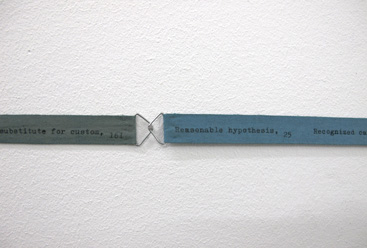
Born in 1970 in Rochester (US)
Lives and works in Cambridge (US)

2005
Ink and milk paint on cotton
1,6 x 200 cm
Year of Purchase: 2009
In old theory books, the summary sometimes resembles a detailed index. Less than an introduction and much more than our contemporary abstracts, it allows the author to announce, in a few phrases, what he intends to demonstrate in each chapter. The summary emanates rare poetry which it is hard not to consider involuntary. It is that poetry that Helen Mirra cultivates and deploys in Cloud the 3, a book constructed entirely out of entries from the personal index which she compiled from John Dewey’s Reconstruction in Philosophy (1920). Mirra continues this work with Human Ken, 24 and Rearranged Incidents, 3, by inscribing these expressions on ribbons of colored fabric.
In several of her works 1, Helen Mirra diverts the form of the index from its purely utilitarian function in order to let it speak in its own fashion. Her interest in Dewey is, in itself, revealing. Dewey wanted to resituate philosophic theories in the cultural context of their emergence, instead of considering them as abstract, purely intellectual creations. He thus sought to maintain in his own work a strong connection between thought and observation of reality. The question of physical production of meaning and, more generally, the relation between thought and the material world, are at the heart of Human Ken, 24 and Rearranged Incidents, 3.
If all of the entries are taken from Dewey’s book and if their condensed layout by the artist remains faithful to the philosopher’s thought, an academic who would use Helen Mirra’s index in order to reference Dewey’s work would certainly be disappointed. The texts which she has chosen are personal and often more imaginative than philosophical. The entries “Remote and abstract generalities, 174” and “Restricted and fallible generality, 80” thus cast doubt on the key principles of Dewey’s thought: abstraction and generalization. These few words are enough to bring back to life Paul Valéry’s critique of the philosophy of art 2. The philosopher studies the general, while it is the singularities that are essential in artworks.
The decontextualization performed by Helen Mirra reveals the plasticity of Dewey’s description which dominates the philosophical meaning that these expressions possess in their original context. These phrases function as tools whose uncanny beauty becomes visible once they have been declared “obsolete.” Steeped in its former life, it can thus change its appearance and acquire a poetic quality.
Klaus Speidel
1 : It’s not the first time that Helen Mirra is working on an index: namely, she created indexes for W.G. Sebald’s and William James’s books.
2 : In his Discourse on Aesthetics, Valéry claims that “the philosophical mind” cannot understand art because it is always “tempted to neglect the singularities and the irregularities which are awkwardly expressed and which plague the distributive uniformity of the method.”